Cat coat genetics

The genetics of cat coat coloration, pattern, length (short, medium or long), and texture is a complex subject, and many different genes are involved.
Cat coat patterns and colors
Cat coat genetics can produce a variety of colors and coat patterns. These are physical properties and should not be confused with a breed of cat. Furthermore, cats may show the color and/or pattern particular to a certain breed without actually being of that breed. For example, cats may have point coloration, but not be Siamese.
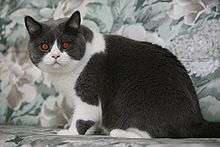
- Bicolor, Tuxedo, and Van
- This pattern varies between the tuxedo cat which is mostly black with a white chest, and possibly markings on the face and paws/legs, all the way to the Van pattern (so named after the Lake Van area in Turkey, which gave rise to the Turkish Van breed), where the only colored parts of the cat are the tail (usually including the base of the tail proper), and the top of the head (often including the ears). There are several other terms for amounts of white between these two extremes, such as Harlequin. Bicolor cats can have as their primary (non-white) color black, red, any dilution thereof, and tortoiseshell (see below for definition).
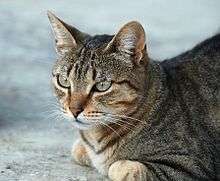
- Tabby
- Striped, with a variety of patterns. The classic blotched tabby (or marbled) pattern is the most common and consists of butterflies and bullseyes. The mackerel or striped tabby is a series of vertical stripes down the cat's side (resembling the fish). This pattern broken into spots is referred to as a spotted tabby. In addition, the individual hairs in a tabby-patterned coat may be banded with different colors, hence a "ticked" tabby. The worldwide evolution of the cat means that certain types of tabby are associated with certain countries; for instance, blotched tabbies are quite rare outside NW Europe, where they are the most common type.
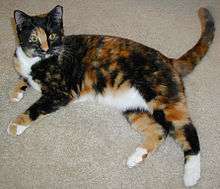
- Tortoiseshell and calico
- This cat is also known as a calimanco cat or clouded tiger cat, and by the abbreviation 'tortie'. In the cat fancy, a tortoiseshell cat is patched over with red (or its dilute form, cream) and black (or its dilute blue) mottled throughout the coat. Additionally, the cat may have white spots in its fur, which make it a 'tortoiseshell and white' cat; if there is a significant amount of white in the fur and the red and black colors form a patchwork rather than a mottled aspect, in North America the cat will be called a calico. All calicos are tortoiseshell (as they carry both black and red), but not all tortoiseshells are calicos (which requires a significant amount of white in the fur and patching rather than mottling of the colors). The calico is also sometimes called a tricolor cat. The Japanese refer to this pattern as mi-ke (meaning "triple fur"), while the Dutch call these cats lapjeskat (meaning "patches cat"). A true tricolor must consist of three colors: a reddish color, dark or light; white; and one other color, typically a brown, black, or blue.[1] Both tortoiseshell and calico cats are typically female because the coat pattern is the result of differential X chromosome inactivation in females (which, as with all normal female mammals, have two X chromosomes). Conversely, cats where the overall color is ginger (orange) are commonly male (roughly in a 3:1 ratio). In a litter sired by a ginger tom, the females will be tortoiseshell or ginger. Male tortoiseshells can occur as a result of chromosomal abnormalities (often linked to sterility) or by a phenomenon known as mosaicism, where two early stage embryos are merged into a single kitten.

- Colorpoint
- The colorpoint pattern is most commonly associated with Siamese cats, but may also appear in any domesticated cat. A colorpointed cat has dark colors on the face, ears, feet, and tail, with a lighter version of the same color on the rest of the body, and possibly some white. The exact name of the colorpoint pattern depends on the actual color, so there are seal points (dark brown), chocolate points (warm lighter brown), blue points (dark gray), lilac or frost points (silvery gray-pink), red or flame points (orange), and tortie (tortoiseshell mottling) points, among others. This pattern is the result of a temperature sensitive mutation in one of the enzymes in the metabolic pathway from tyrosine to pigment, such as melanin; thus, little or no pigment is produced except in the extremities or points where the skin is slightly cooler. For this reason, colorpointed cats tend to darken with age as bodily temperature drops; also, the fur over a significant injury may sometimes darken or lighten as a result of temperature change.
- The tyrosine pathway also produces neurotransmitters, thus mutations in the early parts of that pathway may affect not only pigment, but also neurological development. This results in a higher frequency of cross-eyes among colorpointed cats, as well as the high frequency of cross-eyes in white tigers.
- White cats
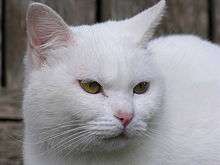
- True albinism (a mutation of the tyrosinase gene) is quite rare in cats. Much more common is the appearance of white coat color that is caused by a lack of melanocytes in the skin. A higher frequency of deafness in white cats is due to a reduction in the population and survival of melanoblast stem cells, which in addition to creating pigment-producing cells, develop into a variety of neurological cell types. White cats with one or two blue eyes have a particularly high likelihood of being deaf.
- Smoke cats
- The bottom eighth of each hair is white or creamy-white, with the rest of the hair being a solid color. Genetically this color is a non-agouti cat with the dominant inhibitor gene; a non-agouti version of the silver tabby. Smoke cats will look solid colored until they move, when the white undercoat becomes apparent. It is mostly found in pedigreed cats (especially longhair breeds) but also present in some domestic long-haired cats.
Genes involved in albinism, dominant white, and white spotting
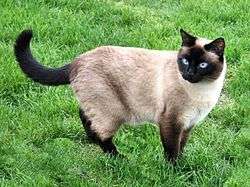
- The "C" gene codes for the enzyme tyrosinase, the first step in pigment production. Its recessive alleles determine whether a cat is a complete albino (pink-eyed) or a temperature sensitive albino. The temperature sensitive albino genotypes are cbcb Burmese (sepia), cscs Siamese (pointed), and cbcs Tonkinese (mink). The cscs gene can turn a cat's eyes blue due to a reduced number of melanocytes, affecting pigmentation of the eyes. If a cat has the dominant C allele, then the cat is non-albino and full pigment production occurs.
- The white masking gene, W/w. The "W" gene prevents the normal replication and migration of pigment-producing cells during embryologic development. As a result, WW and Ww cats have a greatly reduced number of melanocytes and appear white, no matter what other color genes it may carry. Only a cat that is homozygous recessive (ww) will express normal pigmentation. Thus, W is epistatic to the other coat pigmentation genes. Some cats with the W allele of this gene are deaf and/or have depigmentation of the iris of one or both eyes, resulting in blue eye color. White cats are also more likely to get skin cancer.
- The white spotting or piebald spotting gene, S/s, has variable expression, so that an SS cat often has more extensive white patching than an Ss cat. It is this gene that creates the familiar white blaze across the face, a white bib, tuxedo pattern, or dappled paws. A hypothetical Sb allele ("gloving gene") may cause the mittens in Birman and Snowshoe breeds. Some researchers believe that there are separate white spotting genes for distinct forms of white pattern, such as the white locket that some cats have on their neck or bellies.
Genes involved in red, black, brown, and diluted colors
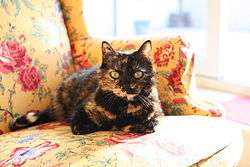
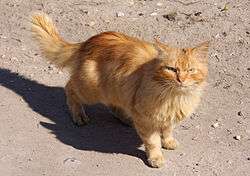
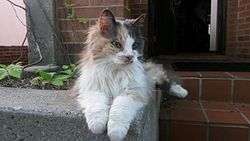
- The sex-linked red gene, O, determines whether there will be red variations to fur color.[2] This gene is located on the X chromosome. In cats with red variants of fur tone, phaeomelanin (red pigment) completely replaces eumelanin (black or brown pigment).[2]
- Males have only one X chromosome, so only have one allele of this gene. O results in red variations, and o results in non-orange fur.
- Since females have two X chromosomes, they have two alleles of this gene. OO results in red toned fur, oo results in non-orange fur, and Oo results in a tortoiseshell cat, in which some parts of the fur are red variants and others areas non-red.[3]
A cat with Oo and white spotting genes is commonly called a calico. The reason for the patchwork effect in female cats heterozygous for the O gene (Oo) is X-inactivation – one or the other X chromosome in every cell in the embryo is randomly inactivated (see Barr body), and the gene in the other X chromosome is expressed.
- Rufous polygenes, as yet unidentified, can affect the richness of the orange/red gene's expression.
For a cat to be tortoiseshell, calico, or one of the variants such as blue-cream or chocolate tortoiseshell, the cat must simultaneously express two alleles, O and o, which are located on the X chromosome. Males normally cannot do this, as they have only one X chromosome, and therefore only one allele, and so calico cats are normally only female. Male tortoiseshell or calico cats occur only if they have chromosomal abnormalities such as the genotype XXY (in which case they are sterile), chromosomal mosaicism (only portions of their cells have the genotype XXY, so these cats may be fertile), or chimerism (a single individual formed from two fused embryos, at least one of which was male). Approximately 1 in 3,000 calico/tortoiseshell cats are male.[4] Chimericism (which may result in fertile male cats) appears to be the most common mechanism.
Genes
- The browning gene B/b/bl codes for tyrosinase related protein-1, an enzyme involved in the metabolic pathway for eumelanin pigment production. Its dominant form, B, will produce black color. Recessive variants are b, producing brown (or chocolate), and bl producing light brown or cinnamon.
- Barrington Brown is a recessive browning gene that dilutes black to mahogany, brown to light brown and chocolate to pale coffee. It is different from the browning gene and has only been observed in laboratory cats.
- The Dense pigment gene, D/d, codes for melanophilin, a protein involved in the transportation and deposition of pigment into a growing hair. When a cat has two of the recessive d alleles (Maltese dilution), black fur becomes "blue" (appearing gray), chocolate fur becomes "lilac" (appearing light brown), cinnamon fur becomes fawn, and orange fur becomes cream.
- Dilution modifier gene, Dm, "caramelizes" the dilute colors as a dominant trait. The existence of this phenomenon as a discrete gene is a controversial subject among feline enthusiasts.
- A mutation at the extension locus E/e (the melanocortin receptor) changes black pigment to amber or light amber. This phenomenon was first identified in Norwegian Forest Cats.
- A modifying factor has also been hypothesized in shaded silver and chinchilla Persians whose fur turns pale golden in adulthood, due to low levels of phaeomelanin production. These cats resemble shaded or tipped goldens, but are genetically shaded or tipped silvers. This is probably related to the phenomenon known as "tarnishing" in silvers.
One can deduce that a grey male cat with a white bib and paws, but showing no tabby pattern:
- has the o variant of the orange gene on its only X chromosome (because the grey color corresponds to black, not orange)
- has at least one S variant of the white Spotting gene (because it has the white bib and paws)
- has two w alleles (because it expresses a fur color)
- has the dominant B allele (because its fur color is a shade of black rather than brown)
- has two d (dilute) alleles (because its fur is grey, rather than black).
Genes involved in fur pattern and shading
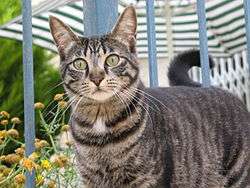
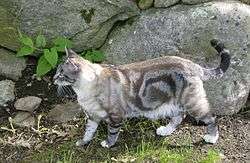
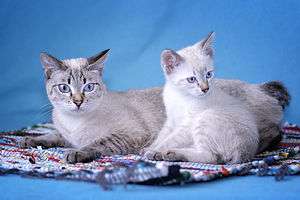
- The agouti gene, A/a which codes for agouti signaling protein. The dominant, wild-type A causes the agouti shift phenomenon which causes hairs to be black pigmented at the tips and orange pigmented at the roots (revealing the underlying tabby pattern), while the recessive non-agouti or "hypermelanistic" allele, a, prevents this shift in the pigmentation pathway. In its homozygous form, aa, this results in black pigment production throughout the growth cycle of the hair. Thus, the non-agouti genotype (aa) masks or hides the tabby pattern, although sometimes a suggestion of the underlying pattern can be seen (called "ghost striping"), especially in kittens. The O allele is also epistatic over the aa genotype. That is, the A to a mutation does not have a discernible effect on red or cream colored cats, resulting in these cats displaying tabby striping independent of their genotype at this locus. This explains why you can usually see the tabby pattern in the orange patches of non-agouti tortoiseshell cats, but not in the black or brown patches.
- The primary tabby pattern gene, Mc/mc, sets the basic pattern of stripes that underlies the coat: the basic wild-type tabby gene, Mc, produces what is called a mackerel striped tabby (stripes look like thin fishbones and may break up into bars or spots); while a recessive mutant, mc, produces a blotched or classic tabby pattern (broad bands, whorls, and spirals of dark color on pale background usually with bulls-eye or oyster pattern on flank), common in Iran, Great Britain and in lands that were once part of the British Empire and Persian Empire. The gene responsible for this differential patterning has been identified as transmembrane aminopeptidase Q (Taqpep), which also produces the king cheetah coat variant.[5]
- Secondary tabby pattern genes such as Ta / ta, at which locus a dominant mutation produces an Abyssinian ticked or non-patterned agouti tabby, having virtually no stripes or bars. (This is one type of unpatterned tabby; the other type of unpatterned tabby is the shaded/chinchilla. See inhibited pigment gene, below.) The dominant ticked tabby allele masks all other tabby patterns.
- Other genes (pattern modifier genes) are theorized to be responsible for creating various type of spotting patterns, many of which are variations on a basic mackerel or classic pattern. There are also hypothetical factors which affect the timing and frequency of the agouti shift, affecting agouti band width and the number and quality of alternating bands of eumelanin and phaeomelanin on individual hairs.
Tabby cats
Tabby cats (AA or Aa), normally have:
- M on forehead. (Visible in ticked tabby cats, but hard to discern in shaded silver/golden, and tipped cats)
- Thin pencil lines on face. (Visible in ticked tabby cats, but hard to discern in shaded silver/golden, and tipped cats)
- Black "eyeliner" appearance and white or pale fur around eyeliner.
- Pigmented lips and paws.
- A pink nose outlined in darker pigment
- Torso, leg, and tail banding. (Torso banding disappears in the ticked tabby.)
Most or all striping disappears in the chinchilla or shaded cat, but it is still possible to identify the cat as a tabby from these other features.
- There is a gene, not yet identified but believed to be related to the agouti gene, in the Chausie breed, that produces silver-tipped black fur similar to Abyssinian ticked fur. The "grizzled" phenomenon is purported to have been inherited from the hybridization of the domestic cat to the jungle cat (Felis chaus).
- The inhibited pigment gene, I/i. The dominant allele (I) produces tipped hairs that are fully colored only at the tip and have a white base. This allele appears to interact with other genes to produce various degrees of tipping, ranging from deeply tipped silver tabby to lightly tipped shaded silver and chinchilla silver. The inhibitor gene interacts with the non-agouti genotype (I-aa) to produce the color known as smoke. The homozygous recessive genotype when combined with the agouti gene (iiA-), produces tabby coloration, which can vary along a spectrum ranging from a deeply patterned brown tabby, to a lighter "golden tabby", to the very lightly colored shaded or chinchilla golden colors. Orange cats with the inhibitor gene (I-O-) are commonly called "cameo".
The genetics involved in producing the ideal tabby, tipped, shaded, or smoke cat is complex. Not only are there many interacting genes, but genes sometimes do not express themselves fully, or conflict with one another. For example, the melanin inhibitor gene sometimes does a poor job blocking pigment, resulting in an excessively gray undercoat, or in tarnishing (yellowish or rusty fur).
Likewise, poorly-expressed non-agouti or over-expression of melanin inhibitor will cause a pale, washed out black smoke. Various polygenes (sets of related genes), epigenetic factors, or modifier genes, as yet unidentified, are believed to result in different phenotypes of coloration, some deemed more desirable than others by fanciers.
Tipped or shaded cats
Here are the genetic influences on tipped or shaded cats:
- Agouti gene.
- Tabby pattern genes (such as Ta masking the tabby pattern).
- Silver or melanin inhibitor gene.
- Factors affecting the number and width of bands of color on each hair (such as the hypothetical wide band gene).
- Factors affecting the amount and quality of eumelanin and/or phaeomelanin pigment expression (such as theorized rufousing factors)
- Genes causing sparkling appearance (such as glitter in the Bengal, satin in the Tennessee Rex, grizzle in the Chausie).
- Factors to clear up residual striping (hypothetical Chaos, Confusion, Unconfused, Erase, and Roan factors).
Genes involved in fur length and texture
Cat fur length is governed by the Long hair gene in which the dominant form, L, codes for short hair, and the recessive l codes for long hair. In the longhaired cat, the transition from anagen (hair growth) to catagen (cessation of hair growth) is delayed due to this mutation. A rare recessive shorthair gene has been observed in some lines of Persian cat (silvers) where two longhaired parents have produced shorthaired offspring.
There have been many genes identified that result in unusual cat fur. These genes were discovered in random-bred cats and selected for. Some of the genes are in danger of going extinct because the cats are not sold beyond the region where the mutation originated or there is simply not enough demand for cats expressing the mutation.
In many breeds, coat gene mutations are unwelcome. An example is the rex allele which appeared in Maine Coons in the early 1990s. Rexes appeared in America, Germany and the UK, where one breeder caused consternation by calling them "Maine Waves". Two UK breeders did test mating which indicated that this was probably a new rex mutation and that it was recessive. The density of the hair was similar to normally coated Maine Coons, but consisted only of down type hairs with a normal down type helical curl, which varied as in normal down hairs. Whiskers were more curved, but not curly. Maine Coons do not have awn hairs, and after moulting, the rexes had a very thin coat.
Curly coated
There are various genes producing curly coated or "rex" cats. New types of rex pop up spontaneously in random-bred cats now and then. Here are some of the rex genes that breeders have selected for:
- r = Cornish Rex, recessive.
- gr (provisional) = German Rex, recessive. Same locus as Cornish, but proposed as a different allele. However, most breeders consider the German Rex to have r/r genotype.
- re = Devon Rex, recessive.
- ro = Oregon Rex (extinct), recessive.
- Se = Selkirk Rex, dominant although sometimes described as an incomplete dominant because the three possible allele pairings relate to three different phenotypes: heterozygous cats (Sese) may have a fuller coat that is preferred in the show ring, while homozygous cats (SeSe) may have a tighter curl and less coat volume. (sese type cats have a normal coat.) This phenomenon may also colloquially be referred to as additive dominance.
- Lp (provisional) = LaPerm, dominant: Lp/lp and Lp/Lp individuals have the same phenotype.
Hairlessness
There are also genes for hairlessness:
- h = French hairless cat, recessive.
- hd = British hairless cat, recessive.
- Hp = Russian Donskoy and Peterbald, dominant.
- hr = Canadian Sphynx cat, recessive.
Some rex cats are prone to temporary hairlessness, known as baldness, during moulting.
Here are a few other genes resulting in unusual fur:
- The Wh gene (dominant, possibly incomplete) results in Wirehair cats. They have bent or crooked hair producing springy, crinkled fur.
- A hypothetical Yuc gene, or York Chocolate undercoat gene, results in cats with no undercoat. However, the proportional relationship between guard, awn, and down hair production varies greatly between all breeds.
- A recessive autosomal gene for Onion hair which causes roughness and swelling on the hairs. The swelling is due to enlargement of the inner core of medulla cells.
- A recessive autosomal gene spf for sparse fur. As well as sparse coat, the hairs are thin, straggly and contorted and there is brown exudate around the eyes and nose and on the chest and stomach. A similar condition is linked to Ornithine Transcarbamylase Deficiency in mice.
See also
- Bicolor cat
- Calico cat
- Tortoiseshell cat
- Point (coat color)
- Barr body
- Tabby cat
- Maltese cat
- Deaf white cat
References
- ↑ French, Barbara. "Torties, Calicos and Tricolor Cats". Fanciers.com. Retrieved 24 October 2005.
- 1 2 "Cat Colors FAQ: Cat Color Genetics". Fanciers.com. Retrieved 2014-08-11.
- ↑ "Feline Breeds, Domestic Cats and Color Patterns". Cats.about.com. Retrieved 2014-08-11.
- ↑ Spadafori, Gina. "Feline Fallacies". The Pet Connection. VeterinaryPartner.com. Retrieved 2008-07-03.
- ↑ Kaelin CB; Xu X; Hong LZ; David VA; McGowan KA; Schmidt-Küntzel A; Roelke ME; Pino J; Pontius J; Cooper GM; Manuel H; Swanson WF; Marker L; Harper CK; van Dyk A; Yue Bisong; Mullikin JC; Warren WC; Eizirik E; Kos L; O'Brien SJ; Barsh GS; Menotti-Raymond M (2012). "Specifying and Sustaining Pigmentation Patterns in Domestic and Wild Cats". Science. 337 (6101): 1536–1541. doi:10.1126/science.1220893. PMID 22997338.
- Genetics for Cat Breeders and Veterinarians Carolyn M. Vella, Lorraine M. Shelton, John J. McGonagle, Terry W. Stanglein. Butterworth-Heinemann Ltd ISBN 0-7506-4069-3
- Cat Genetics A C Jude.
- Coat Color Genetics Heather E. Lorimer.
External links
- Cat Genetics articles in plain English
- Cat Gene Symbols
- The Pigment Parade: White and White Spotting in the Cat
- Inhibitor gene diagram and article